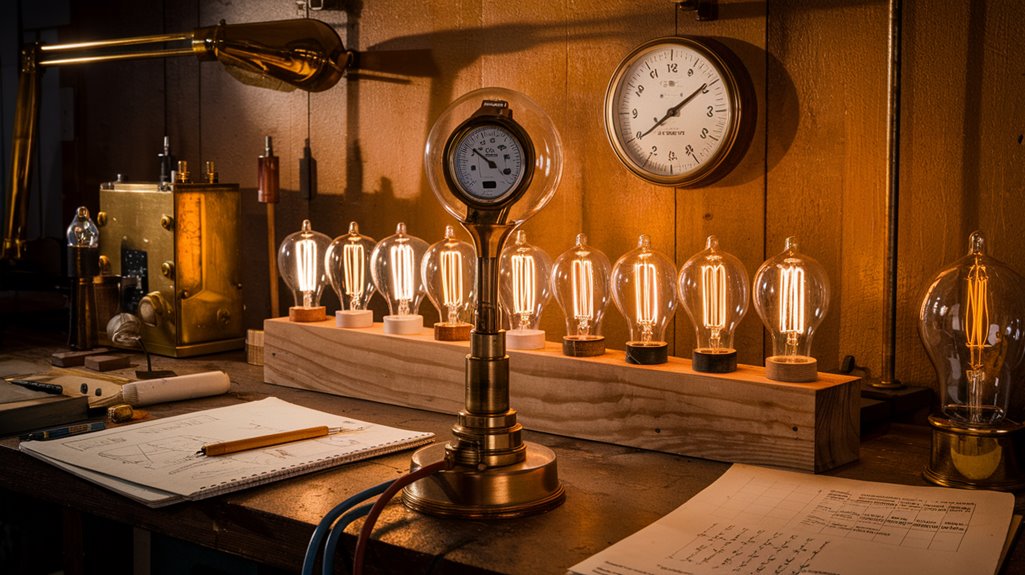Exposing the Phoebus Cartel: When Bulbs Burned Out on Purpose
You've probably never questioned why your light bulbs burn out when they do, but there's a dark history behind their limited lifespan. In the 1920s, the world's largest light bulb manufacturers orchestrated one of history's most successful conspiracies. They deliberately engineered bulbs to fail, transforming what was once a durable product into a disposable commodity. The story of the Phoebus Cartel reveals how corporate greed dimmed the lights on technological progress—and that's just the beginning of this illuminating tale.
The Birth of a Shadowy Alliance

While electric lighting had already revolutionized modern life by the 1920s, a group of powerful manufacturers saw an opportunity to control its future. On January 15, 1925, industry giants like Osram, General Electric, Philips, and Tungsram joined forces to create the Phœbus S.A. Compagnie Industrielle pour le Développement de l'Éclairage in Geneva, Switzerland.
You might think this cartel formation was about innovation, but their true mission was far more calculated. They deliberately established standards to limit bulb longevity to just 1,000 hours, ensuring consumers would need frequent replacements. The cartel's origins can be traced back to when Osram founded IGPV in 1921.
Through careful coordination, these manufacturers divided market territories, controlled patents, and set prices to maximize profits. The cartel first met at a historic meeting in Geneva on December 23, 1924. What began as a secret agreement would soon reshape the entire lighting industry for decades to come.
Engineering Darkness: How They Dimmed Innovation
Beneath the guise of standardization, the Phoebus Cartel systematically dismantled decades of progress in lighting technology.
You'd be shocked to learn they slashed bulb lifespans from 2,000 to just 1,000 hours, enforcing this reduction through rigorous testing and hefty fines for manufacturers who dared to exceed these limits.
This calculated innovation stagnation wasn't just about controlling how long your bulbs would last – it reshaped the entire industry's trajectory. The cartel's deceptive practices began with a critical meeting during Christmas 1924 when industry leaders plotted their course.
Through consumer deception, they'd transformed light bulbs from durable goods into disposable commodities.
Their tight grip on patents and territories crushed competition, while their obsession with planned obsolescence steered research away from efficiency and durability.
The cartel's influence was particularly impactful given that only 35% of US households had electricity when they began their market manipulation.
The Price of Light: Market Manipulation Exposed
Through carefully orchestrated market controls, the Phoebus cartel transformed light bulbs from affordable necessities into profit-driven commodities. You wouldn't have known it then, but major manufacturers like Osram, Philips, and General Electric were engaged in systematic price fixing that artificially inflated the cost of keeping your home lit.
The scale of consumer deception was staggering. Not only did they slash bulb lifespans from 2,500 to 1,000 hours, but they also penalized companies that dared to produce longer-lasting products. The cartel enforced these standards with heavy fines on member companies who exceeded the lifespan limits. Their actions were reminiscent of modern pump-and-dump schemes that plague financial markets today.
You were forced to buy replacements more frequently, while manufacturers reaped the rewards of their coordinated scheme. This manipulation set a troubling precedent that persisted long after the cartel's 1939 dissolution, showing how corporate greed could successfully dim technological progress at consumers' expense.
Behind Closed Doors: Testing and Enforcement
Inside a secretive Swiss laboratory, the Phoebus cartel orchestrated one of history's most systematic quality control schemes – not to improve products, but to guarantee they'd fail on schedule.
You'd be shocked to learn how meticulously they tested every bulb. When manufacturers sent their samples, laboratory technicians scrutinized them against strict 1,000-hour lifespan standards.
The cartel's stark manipulation became evident as bulb lifespans plummeted from 2,500 to 1,000 hours. Major industry players like GE, Osram, and Philips collaborated in this widespread deception.
If your bulb burned longer, you'd face steep fines in Swiss francs. The testing procedures were relentless, forcing engineers to tackle significant compliance challenges as they worked to deliberately decrease bulb lifespans.
The scheme eventually crumbled when U.S. courts prosecuted General Electric under the Sherman Anti-Trust Act.
The legal proceedings exposed how the cartel's enforcement system had systematically manipulated the market, marking the end of their planned obsolescence scheme.
Legacy of Planned Obsolescence

The Phoebus Cartel's downfall didn't end the practice they'd pioneered – instead, it sparked a revolution in how companies approach product design.
Since 1928, businesses have followed profit-driven obsolescence as originated by Justus George Frederick.
Today, you'll find their influence across multiple industries, from smartphones with limited software updates to fashion items designed to fall apart after a few uses. The practice ensures a two to three year replacement cycle for most consumer electronics.
While companies continue to prioritize profits through planned obsolescence, you're now part of a growing movement demanding sustainable alternatives and stronger consumer rights.
The environmental impact has become impossible to ignore, with mountains of electronic waste and discarded appliances filling landfills.
This legacy has prompted important discussions about corporate responsibility and environmental stewardship.
As you become more aware of these practices, you're better equipped to make informed choices and support companies that prioritize durability over disposability.
Breaking the Bulb Trust: Legal Battles and Public Outcry
When legal battles finally erupted against the Phoebus cartel, U.S. antitrust regulators targeted General Electric and its co-conspirators for violating the Sherman Anti-Trust Act. The legal ramifications were significant, as courts found the cartel's primary goal was to increase profits by deliberately limiting light bulb lifespans, creating an illegal monopoly.
While consumer awareness remained low during the cartel's operation, you might be surprised to learn that it wasn't until the 1973 publication of "Gravity's Rainbow" that the public began understanding how they'd been deceived.
The cartel's practices were officially banned in 1953, but World War II had already forced its dissolution in 1939.











